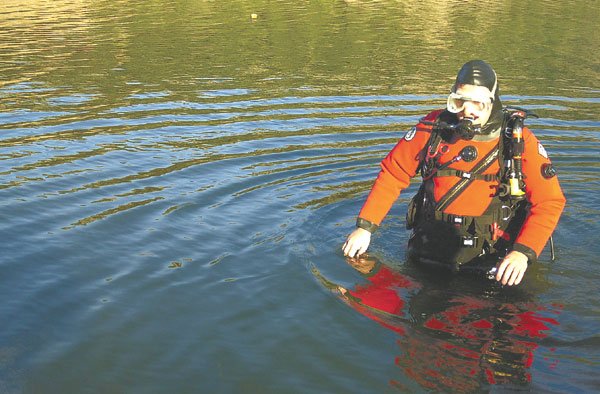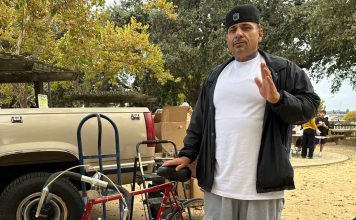Underwater Search and Rescue Unit locates vehicles, drowning
victims
Morgan Hill – Imagine swimming in water so dark you can’t see your hand in front of your face. Imagine knowing the underwater world you’re in is riddled with fishing line, cars, junk and debris that could ensnare you as you search by hand for a cadaver. Imagine knowing there was a risk you might not come back to the surface alive. Now imagine volunteering for the job.
The 15 members of the Santa Clara County Sheriff’s Office Underwater Search and Rescue Unit Dive Team do just that. They are the only dive team in the county and consist of 12 deputy divers specially trained in rescue diving, two volunteers who operate special ROV technology and a deputy sergeant who searches the water’s edge with a bloodhound.
“We all do it because we want to help the victim’s families. We give families closure and that’s what it’s all about,” said Lt. Dale Unger, who commands the special unit. “Being able to say, ‘Here – here’s your husband or brother back.'”
But the job is extremely dangerous.
“I personally have been tangled in fishing lines,” Unger said.
Divers carry cutting shears and knives for this very reason.
“That’s one of my biggest fears – is somebody getting hurt,” he said.
Team members are scattered throughout the county working their full-time assignments on patrol and in the courts. During the summer, they are on call 24 hours a day and are called out 15 to 20 times a year to locate submerged vehicles, find evidence such as guns and recover bodies of drowning victims. Occasionally the team has been called out of the county in mutual aid calls to assist outside agencies. Sometimes the team is reimbursed for the expenses, other times they operate under a mutual aid agreement.
For instance, the team was sent to help find the body of Laci Peterson with the use of their side scan sonar machine – a $50,000 gift from the Department of Homeland Security two years ago that draws the image of the waterbed floor by creating a sound picture. Sound waves bounce off objects on the floor and draw an image on a laptop screen.
“It takes a lot of time, a lot of practice to learn how to read these. It’s like learning a new language,” said Sgt. Don Ray, pointing to the computer screen Tuesday during a training session of Anderson Lake.
“That’s obviously a rock,” the 15-year veteran said, pointing to a small round dark spot.
Divers are taught to read the images by their shape and size. Questionable images can be marked by GPS coordinates. To search an area the size of a football field by hand could take up to a week. Using the side scan sonar it can be done in less than two hours.
“By hand, the chances of finding a person is luck at best,” Ray said. “We have the privilege of having a very powerful unit. To someone else a body looks like a rock – to us – a body looks like a body.”
Members carry about 80 pounds of equipment, and for safety reasons, dive in pairs up to 80 feet deep. The side scan sonar allows them to do look even deeper.
Under special emergency circumstances, a diver may go in the water alone. But normally they perform an underwater sweep by leaving a diver on shore holding a rope attached to divers below the surface. They hold the line and swim in a semi-circle pattern sweeping the bottom of the waterbed with their hands, overlapping so they don’t miss anything.
“You do a sweep search until you literally bump into the body,” Unger explained. “There’s some psychological stress involved, especially for younger divers. You’re going into black water and bumping into a body and you don’t know what part of the body you’re going to hit.”
The last dive the team went was Aug. 8 when a 61-year-old man drowned while swimming at Parkway Almaden Lakes. No one saw exactly where he went down, and this type of accuracy can be the difference between searching for minutes and searching for days. His body was found within 70 minutes of the call.
“That told us we are a viable rescue unit,” Ray said.
Sheriff Laurie Smith was the first female diver on the team. Kristin Anderson is the second. This is her third year as a deputy and second year on the dive team.
Anderson had a job in marketing after college but decided she really wanted to be a police officer.
“The reason why I came here was because they had a dive team,” the 28-year-old said. “It’s peaceful, you can’t hear anything. It’s completely dark. You know how you go into a closet and your eyes adjust and you can see the shadows? Here, there’s no shadows.”
The idea of recovering a body to help families understand what really happened to their loved one is a comporting thought to an unnerving situation.
“It’s a horrible feeling but the family needs closure,” she said. “It needs to be done and somebody has to do it.”














